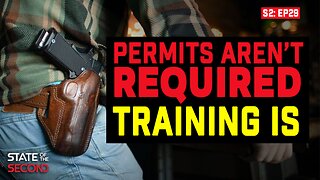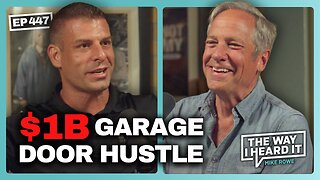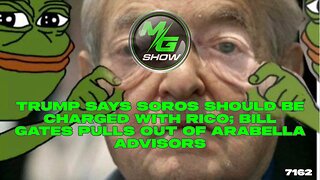Premium Only Content
![California High-Speed Rail Project Drone Flyover UPDATE - Wasco, CA: 5/14/22 [4K 60FPS HDR]](https://1a-1791.com/video/s8/1/6/x/k/f/6xkfe.qR4e-small-California-High-Speed-Rail-.jpg)
California High-Speed Rail Project Drone Flyover UPDATE - Wasco, CA: 5/14/22 [4K 60FPS HDR]
Support My Work On Patreon! 👉 https://www.patreon.com/DroneZoneFlyovers
California High-Speed Rail (CAHSR or CHSR) is a publicly funded high-speed rail system under construction in the U.S. state of California. Its goal is to connect the Anaheim Regional Transportation Intermodal Center in Anaheim and Union Station in Downtown Los Angeles with the Salesforce Transit Center in San Francisco via the Central Valley, providing a one-seat ride between Union Station and San Francisco in 2 hours and 40 minutes, a distance of 380 miles (610 km).
Future extensions (in Phase 2) are planned to connect southward to stations in San Diego County via the Inland Empire, as well as northward to Sacramento. It will be implemented in a number of self-supporting segments, as resources become available.
CAHSR plans to eventually operate on dedicated, grade-separated tracks for the entirety of its route between San Jose and Burbank with maximum speeds of up to 220 miles per hour (355 km/h). The San Francisco–San Jose and Los Angeles–Anaheim sections will be shared with local trains in a "blended system." The project is owned and managed by the state of California through the California High-Speed Rail Authority (CHSRA). The Bakersfield to Los Angeles segment would be the first instance of a direct passenger train route between the cities since the termination of the Southern Pacific Railroad's San Joaquin Daylight in 1971.
The CAHSRA was established by an act of the California State Legislature and tasked with presenting a high-speed rail plan to the voters. This plan, Proposition 1A, was approved by voters in 2008 after the presentation and was assigned a $9 billion bond to begin construction on the initial leg of the network.
The project has been widely described as troubled,being far behind schedule and suffering from management turmoil, problems with procuring land, and engineering issues. In addition, the cost of the project has risen from an estimate of $33 billion in 2008 to $80 billion by 2020. According to a poll in June 2021, 42 percent of California voters supported halting the project, while 41 percent supported continuing it.
The California High-Speed Rail Authority was established in 1996 after decades of advocacy for building a high speed rail system in California. The passage of Proposition 1A in 2008, followed by the awarding of federal stimulus funds in 2010, established the initial funding for the California High-Speed Rail system. Construction contracts began to be awarded in 2013, and the groundbreaking ceremony for initial construction was held on January 6, 2015.
Citing delays and cost overruns and lack of transparency from the project's leadership, Governor Gavin Newsom reaffirmed the state's commitment to the project on February 12, 2019. Newsom said the state will prioritize construction a segment already underway through California's Central Valley, arguing it would revitalize the economically depressed region. The state will complete the planning for the remaining segments and seek federal funds for their construction. He also said he would replace the head of the state board that oversees the project and pledged more accountability for contractors that run over on costs.
-
 1:18
1:18
WildCreatures
2 days ago $0.63 earnedTourists unintentionally come face to face with jaguar in Brazil's Pantanal
1.4K14 -
 40:36
40:36
State of the Second Podcast
17 hours agoWhy Training Is an Investment in Your Life (ft. Tre’Von Barber)
41 -
 1:03:43
1:03:43
Dialogue works
1 day ago $0.40 earnedCol. Larry Wilkerson: Warning Signs Everywhere: U.S. on the Verge of Disaster
16.1K9 -
 1:09:42
1:09:42
Mike Rowe
7 days agoHow Did THIS Dirty Job Make Tommy Mello A Billionaire?! | #447 | The Way I Heard It
88.6K21 -
 2:01:37
2:01:37
MG Show
19 hours agoTrump Says Soros Should be Charged with RICO; Bill Gates Pulls Out of Arabella Advisors
12.9K28 -
 1:14:00
1:14:00
Steve-O's Wild Ride! Podcast
6 days ago $1.88 earnedLilly Singh Talks S*x Education With Steve-O | Wild Ride #264
17.7K4 -
 52:48
52:48
Futures Edge: Finance Unfiltered with Jim Iuorio and Bob Iaccino
1 day ago $1.34 earnedTrump’s Latest Initiatives Explained
18.9K -
 4:36:31
4:36:31
FreshandFit
10 hours agoWhat Are Things Women Wished Men Knew About Them?
69.8K114 -
 2:04:11
2:04:11
Side Scrollers Podcast
19 hours agoCracker Barrel CANCELS Rebrand + OG YouTuber Has Brain Tumor + More | Side Scrollers IN STUDIO
33.1K6 -
 19:26
19:26
GritsGG
11 hours agoChat Picked My Hair Color! All Pink Loadout & Operator Challenge!
9.99K3